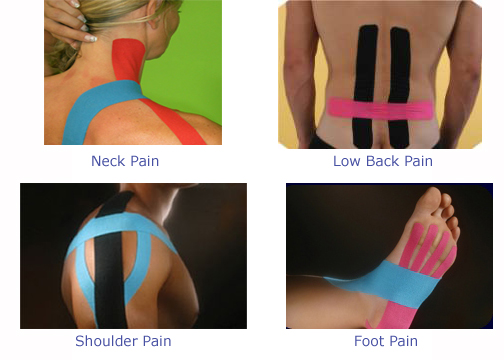 The Magic of Kinesio Taping
The Magic of Kinesio Taping
The Kinesio Taping® Method was developed by Dr. Kenzo Kase, a Japanese-born chiropractor who saw that tape used in rehabilitation was either rigid or multi-directional in elasticity. He developed it in the early 1970s using the concept of kinesiology.
It differs from traditional sports taping by using a elastic tape that has similar properties to skin and is the only tape with unidirectional, or longitudinal elasticity (approximately 140 percent elasticity). There is no medicine in this tape. It is heat activated and hypo-allergenic. It consists of 100-percent cotton containing air circulation waves for breathability.
Kinesio Tape has been used in Olympic competition since 1988, but it got a big boost when the company donated rolls to physical therapists to use on athletes at the 2008 Beijing Olympics. As Olympic athletes plastered in bright blue stripes danced across screens around the world, the company soon watched its online sales triple.
“Sometimes we’d be so wrapped up in hot-pink tape that we’d look like dolls, a bunch of broken dolls. But the tape worked, so we kept it, because it could fix things.”
– Tour de France champion Lance Armstrong, in his 2003 book Every Second Counts
Now athletes ranging from the Green Bay Packers to Serena Williams swear by the stuff, and some independent research supports the athletes’ loyalty. A 2008 study of college-aged patients with rotator cuff tendonitis, a shoulder injury, noted improved range of motion and less pain when Kinesio tape was applied as directed.
The Benefits
The tape is placed over and around muscle groups to assist and prevent over-contraction, reducing cramping and/or spasm. Kinesio Taping supports the client while still maintaining their full range of motion. It also allows the client to still participate in normal physical activities, while having the support of the tape.
A second use of the Japanese taping method is in the acute stage of rehabilitation, where it helps prevent over-contraction of muscle groups as well as encourage healthy lymph flow.
Kinesio Taping reduces pain and encourages lymphatic drainage by lifting the skin, as a result pressure and irritation are removed from the neural and sensory receptors, alleviating pain.
What Is it Used For?
It is effective on a number of conditions including neck pain, shoulder pain, lower back pain, plantar fasciitis, carpal tunnel syndrome, IT band tightness, knee pain and ankle sprains.
How Does it Work?
On skin, the Kinesio Tape® pulls the upper layers of skin, creating more space between the dermis and the muscle.
The space created is believed to relieve pressure on the lymph channels in the area between the muscle and the dermis, creating more space for lymph flow and thus better lymph drainage through an affected area. This space also houses various nerve receptors that send specific information to the brain.
When the space between the epidermis and the muscle is compressed, such as during an injury, these nerve receptors are compressed and send information to the brain regarding continuous touch, light touch, cold, pain, pressure, and heat. This information causes the brain to send out certain signals to the body on how to react to particular stimuli.
Kinesio Tape® alters the information that these receptors send to the brain and causes a less reactive response in the body, allowing the body to work in a more normal manner and removing some of the roadblocks that normally slow down the healing process.
How Long Does it Last?
It’s elasticity is meant to last 3 to 5 days. When the elasticity is lost, the client gently removes the tape to let the skin recover for about 2 days before their next massage session.
How Much Does it Cost?
It’s FREE!
Watch this video to see Kinesio Taping in action:
Watch Kinesio Taping in the News:
Sources: Kinesiotaping.com, NPR.org


